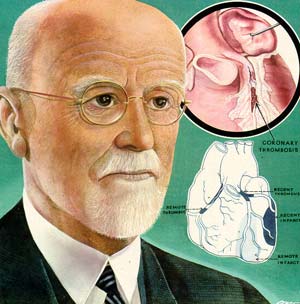Identify and treat congenital bleeding
When the body has an abnormality in the synthesis or globin structure, abnormal yeast or erythrocyte membrane can lead to erythrocyte death earlier than usual, causing anemia for the body, people call is congenital hemolytic disease.
Congenital hemolytic disease
The disease was officially described by clinical manifestations by James B. Herrick in 1910. Since then, many scientists have been deeply investigating the disease and thanks to the progress of genetics. it is possible to know exactly which lesions of the genes have caused the disease.

James B. Herrick (Photo: kumc.edu)
One can classify the disease as follows: Unusual diseases of red blood cells include lack of enzyme G6PD, lack of enzyme pyruvat kinase. Minkowski's disease of pink membrane membranes The ffard, erythrocytes, spherical erythrocytes, paroxysmal nocturnal hematuria.
In addition, there are abnormalities in hemoglobin due to controlled gene damage and quality disorders of hemoglobin.
The disease occurs in both men and women. Depending on the balance between the level of hemolysis and the compensatory capacity of bone marrow, the disease may be detected immediately during fetal period (pregnancy, stillbirth), after when the child is born or until adulthood is discovered.
Symptoms of hemolysis
Anemia, jaundice, dark-colored urine with intermittent colds, hepatosplenomegaly, sometimes with gallstones. Bone hypertrophy may cause facial deformity: frontal bone tumor, hypertrophy of the cheekbones, creating "face of congenital bleeding" (rough forehead, cheekbones, flat nose, teeth). Severe anemia can slow the body's growth and delay puberty.
In contrast to cases of iron deficiency anemia, iron supplementation for the body is needed, in patients with congenital hemolysis may manifest iron overload (iron overload). Stagnant iron in the body is the result of hemolysis, the body increases absorption due to anemia and blood transfusion many times. Iron overload in organs can lead to: skin darkening, diabetes, heart failure, liver failure .
How to diagnose the disease?
In addition to the clinical manifestations mentioned above, the doctors must also base on tests including reduced blood pigmentation. Red blood cells may be small (in the body related to hemoglobin) or of normal size (lack of G6PD enzyme), so in some cases, small red blood cells, the number of red blood cells does not decrease but sometimes increases. . Bilirubin in the blood increases, especially indirect bilirubin. Haptoglobin decreased, iron and ferritin increased. Hemoglobin electrophoresis may indicate what type of abnormal hemoglobin is. Quantitative determination of G6PD enzyme, pyruvat kinase decreased in cases of lack of these enzymes congenital. It is also possible to see skull damage on X-ray film. DNA testing can indicate the exact location of genetic deficiencies.
Cure
Routine blood transfusion : Depending on the severity of the disease, the doctor determines the distance between blood transfusions. Inject or take iron supplements periodically to reduce complications from iron overload. In addition, folic acid can be added. For cases of splenomegaly that increase the need for transfusion or the risk of splenic splenectomy, the splenectomy should be removed.
For patients with congenital G6PD deficiency, it is necessary to avoid the use of drugs or food with oxidizing agents such as antimalarial drugs, quinolon, peas, etc. Prenatal diagnosis with couples disease is necessary to help parents and physicians decide whether or not to have an abortion. Because it is a congenital disease that cannot be completely cured, patients need to have a proper lifestyle, avoid heavy labor as well as strong physical activity.
- Bleeding from the teeth, little blood loss but not taken lightly
- New surgical method to treat congenital heart disease
- How to overcome bleeding gums
- Using this tip, you will stop bleeding from the tooth immediately
- Bleeding root disease
- Artificial bones treat scoliosis
- Thrombocytopenia during pregnancy
- Going to cure congenital olfactory loss?
- Detection of the 15th gene causes congenital blindness
- Find the recessive gene that causes congenital blindness
- Foam hemostatic internal injury
- Congenital haemorrhage - The disease is hard to cure, easy to prevent
 Green tea cleans teeth better than mouthwash?
Green tea cleans teeth better than mouthwash? Death kiss: This is why you should not let anyone kiss your baby's lips
Death kiss: This is why you should not let anyone kiss your baby's lips What is salmonellosis?
What is salmonellosis? Caution should be exercised when using aloe vera through eating and drinking
Caution should be exercised when using aloe vera through eating and drinking